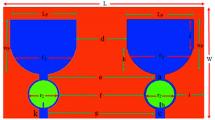Abstract
This paper presents a theoretical analysis of multiple-input multiple-output (MIMO) orthogonal frequency division multiplexing in the presence of nonlinear dual-band power amplifiers. A two-dimensional memory polynomial model is used to describe the dual-band power amplifier. It is analytically shown that the effect of nonlinearity impairment in the transmitter can be modeled by a complex coefficient and a nonlinear additive noise. An analytical formulation is provided for symbol error rate (SER) of this system considering a frequency selective MIMO channel. The experimental results have been deployed to extract a realistic model for a dual-band amplifier. Also, the model of the linearized power amplifier has been extracted after applying digital pre-distortion (DPD). The proposed model is validated by simulation for 2 × 2 and 2 × 4 MIMO systems. The results show that the analytical model maps well onto the simulation. Also, it is shown that the DPD is able to compensate for the nonlinearity effect of the dual-band power amplifier as the SER is improved.




Similar content being viewed by others
References
Paulraj, A. J., Gore, D. A., Nabar, R. U., & Bolcskei, H. (2004). An overview of MIMO communications—A key to gigabit wireless. Proceedings of the IEEE, 92(2), 198–218.
Van den Bos, C., Kouwenhoven, M. H. L., & Serdijn, W. A. (2001). Effect ofsmooth nonlinear distortion on OFDM symbol error rate. IEEE Transactions on Communications, 49(9), 1510–1514.
Chen, B., Yang, C., & Liao, W. (2012). Robust fast time-varying multipath fading channel estimation and equalization for MIMO-OFDM systems via a fuzzy method. IEEE Transactions on Vehicular Technology, 61(4), 1599–1609.
Roblin, P., Myoung, S. K., Chaillot, D., Kim, Y. G., Fathimulla, A., Strahler, J., et al. (2008). Frequency-selective predistortion linearizationof RF power amplifiers. IEEE Transactions on Microwave Theory and Techniques, 56(1), 65–76.
Bohara, V. A., & Ting, S. H. (2009). Analytical performance of orthogonal frequency division multiplexing systems impaired by a non-linear high power amplifier with memory. IET Communications, 3(10), 1659–1666.
Vaezi, A., Abdipour, A., & Mohammadi, A. (2012). Nonlinear analysis of microwave amplifiers excited by multicarrier modulated signals using envelop transient technique. Analog Integrated Circuits and signal Processing, 72, 313–323.
Yiming, L., O’Droma, M., & Ye, J. (2014). A practical analysis of performance optimization in OSTBC based nonlinear MIMO-OFDM systems. IEEE Transactions on Communications, 62(3), 930–938.
Iofedov, I., & Wulich, D. (2015). MIMO–OFDM with nonlinear power amplifiers. IEEE Transactions on Communications, 63(12), 4894–4904.
Hemesi, H., Abdipour, A., & Mohammadi, A. (2013). Analytical modeling of MIMO-OFDM system in the presence of nonlinear power amplifier with memory. IEEE Transactions on Communications, 61, 155–163.
Hemesi, H., Abdipour, A., & Mohammadi, A. (2014). Statistical modelling of a non-linear high-power amplifier with memory in multi-input-multi-output orthogonal frequency division multiplexing systems. IET Communications, 8(5), 714–721.
Bassam, S. A., Helaoui, M., & Ghanouchi, F. M. (2009). Crossover digital predistorter for the compensation of crosstalk and nonlinearity in MIMO transmitter. IEEE Transactions on Microwave Theory and Techniques, 57(5), 1119–1128.
Amiri, M. V., Bassam, S. A., Helaoui, M., & Ghannouchi, F. M. (2013). Estimation of crossover DPD using orthogonal polynomials in fixed point arithmetic. AEU International Journal of Electronics and Communications, 67(11), 905–909.
Amin, S., Landin, P. N., Handel, P., & Ronnow, D. (2014). Behavioral modeling and linearization of crosstalk and memory effects in RF MIMO transmitters. IEEE Transactions on Microwave Theory and Techniques, 62(4), 810–823.
Fu, Z., Anttila, L., Abdelaziz, M., Valkama, M., & Wyglinski, A. M. (2015). Frequency-selective digital predistortion for unwanted emission reduction. IEEE Transactions on Communications, 63(1), 254–267.
Bassam, A., Helaoui, M., & Ghannouchi, F. M. (2011). 2-D digital predistortion (2-D-DPD) architecture for concurrent dual-band transmitters. IEEE Transactions on Microwave Theory and Techniques, 59(10), 2547–2553.
Younes, M., & Ghannouchi, F. M. (2013). On the modeling and linearization of a concurrent dual-band transmitter exhibiting nonlinear distortion and hardware impairments. IEEE Transactions on Circuits and Systems I: Regular Papers, 60(11), 3055–3068.
Kiessling, M., & Speidel, J. (2003). A nalytical performance of MIMO zero-forcing receivers in correlated ray leigh fading environments. Processing IEEE Workshop SPAWC, 2003, 383–387.
Author information
Authors and Affiliations
Corresponding author
Appendices
Appendix 1: Derivation for complex coefficients, \(\mu_{b q,k}^{i}\)
In order to calculate \(\mu_{b q,k}^{i}\), from (11) we have:
In (22), \(\beta_{b q,k}^{i}\) and \(a_{b k}^{i}\) can be replaced by (10) and its IDFT representation, respectively. Thus,
Also, it can be rewritten as,
As \(x_{b \left[ \upsilon \right]}^{i}\) and \(x_{b \left[ n \right]}^{i}\) are Gaussian random variable, they are independent when \(n \ne \upsilon\). So the expectation value is zero unless \(n = \upsilon\) therefore,
Considering the central momentum of Rayleigh- distributed random variable, \(E\left[ { \left| x \right|^{p} } \right] = \sigma^{p} 2^{{\frac{p}{2}}} \varGamma \left( {1 + \frac{p}{2}} \right)\) where \(\sigma^{2} = P_{i b} /\left( {2N} \right)\), (22) can be written as:
Consequently (12) is extracted.
Appendix 2: Derivation for Mean of Nonlinear Noise
In this part we prove that the mean of nonlinear noise, \(\eta _{b k}^{i}\), is zero. For this purpose, we have,
As \(a_{b k}^{i}\) is a zero mean random variable, \(E\left[ {\eta _{b k}^{i} } \right] = E\left[ {\beta_{b k}^{i} } \right]\)
Also, \(\beta_{b k}^{i} = \mu_{b k}^{i} a_{b k}^{i} + \eta _{b k}^{i}\) where \(\beta_{b k}^{i} = \mathop \sum \limits_{q = 0}^{Q - 1} \beta_{b q,k}^{i} e_{{}}^{ - j2\pi kq/N}\), So,
Where \(\varphi_{p,k}^{i} = \mathop \sum \limits_{q = 0}^{Q - 1} C_{b p, p1, q }^{i} e_{{}}^{ - j2\pi kq/N}\)
Since \(x_{b \left[ n \right]}^{i} \left| {x_{b \left[ n \right]}^{i} } \right|^{p - p1} \left| {x_{bb \left[ n \right]}^{i} } \right|^{p1}\) is circularly symmetric, its expectation value is zero. So, \(E\left[ {\beta_{b k}^{i} } \right] = 0\)
Appendix 3: Derivation for Variance of Nonlinear Noise
In order to calculate the variance of the nonlinear noise, starting from \(\beta_{b k}^{i} = \mu_{b k}^{i} a_{b k}^{i} + \eta _{b k}^{i}\), and considering \(\eta _{b k}^{i}\) as a zero-mean random variable, we have,
where \(\left| {\beta_{bk}^{i} } \right|^{2} = \left( {\beta_{bk}^{i} } \right)\left( {\beta_{bk}^{i} } \right)^{*}\). By replacing \(\beta_{b k}^{i}\) from (29),
(32) can be rearranged as,
The expectation value is zero unless \(n_{2} = n_{1} = n\), so,
and,
Therefore, the (14) is extracted.
Rights and permissions
About this article
Cite this article
Vaezi, A., Abdipour, A., Mohammadi, A. et al. Analysis of MIMO-OFDM system impaired by nonlinear dual-band power amplifiers. Analog Integr Circ Sig Process 89, 205–212 (2016). https://doi.org/10.1007/s10470-016-0821-2
Received:
Revised:
Accepted:
Published:
Issue Date:
DOI: https://doi.org/10.1007/s10470-016-0821-2




